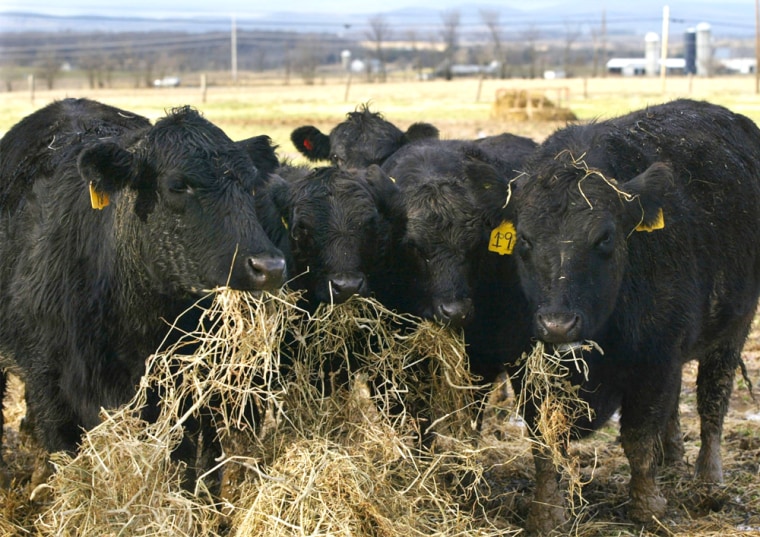Organic. Natural. No added hormones. No antibiotics. Grass-fed. Free-range.
An often-confusing array at a higher cost awaits consumers interested in alternatives to mass-produced beef after mad cow disease was found last month in a Washington dairy cow.
This spring the government is expected to approve new rules that should clear up some of the confusion.
Of all the current labels, the most stringently regulated is organic. Only organic beef meets strict standards verified by independent inspectors.
To be certified organic, beef must come from cattle fed grass or grain -- all vegetarian -- grown without pesticides. The meat must be traceable from the ranch to the dinner table.
But organic beef can be roughly double the price of ordinary mass-produced beef.
Other labels, like natural, may boost the cost by 50 percent. And what does that label mean? For consumers, confusion reigns.
"I think I would go more with 'natural,' and I'm trying to learn what it means, but I don't really trust the label," said Denver shopper Susan Rodgers, who tries to buy most of her meat from an area farmer.
"The only way to know is to call the producer and ask what the label means," said Ruth Kava, nutrition director of the American Council on Science and Health.
What does 'natural' mean?
Products labeled "natural" simply have to be minimally processed with no artificial ingredients.
Virtually any fresh-meat product can be labeled natural, said Roy Moore, one of those selling "natural" beef. Founder of Denver-based Maverick Ranch, he says his meat is also free of antibiotics and additional hormones. And he says his cows are never fed animal products, a comfort for people worried about mad cow disease, but you'll have to take his word for it.
"That's the frustrating thing," said Sue Jarrett, a rancher near Wray on Colorado's Eastern Plains. "You can put anything you want on a label and you have the right to say, 'This is what it means to me.'"
Food labels making such claims must be approved by the U.S. Agriculture Department's Food Safety and Inspection Service, which works with the Agriculture Marketing Service to develop standards.
The goal is consistency among labels, so that one farmer's claim of natural, hormone-free beef, for example, means the same thing as that of another farmer, said Robert Post, director of the service's labeling and consumer protection staff.
Under current labeling rules, "natural" means no artificial ingredients or added color, and minimal processing like grinding, smoking or freezing.
Claims such as no hormones, no antibiotics, free-range or pasture-raised, or grass-fed or grain-fed may be approved if producers supply sufficient documentation to satisfy the FSIS. Inspections to verify claims can be conducted if the agency believes something is wrong with a claim, Post said.
New rules to define standards
Proposed rules expected to be made final this spring are designed to set consistent definitions for claims including:
- No hormones: Animals never received supplemental hormones. A related claim of no hormones used during finishing would mean the animals did not receive supplemental hormones during the time before slaughter.
- No antibiotics: Animals never received antibiotics. A related claim of no subtherapeutic antibiotics means no feed laced with antibiotics; and no detectable antibiotic residue would mean any antibiotic treatment was ended long enough before slaughter to ensure the meat was free of traces of antibiotics.
- Free-range or pasture-raised: Animals that have had continuous and unconfined access to pasture throughout their lives and have never been confined to a feedlot, where movement is limited.
- Grass-fed: Cattle that throughout their lives received 80 percent or more of their primary energy source from grass, green or range pasture or forage. Grain-fed would mean average grain consumption must equal at least half of the feed for 30 days for cows and 100 days for steers and heifers.
Why so expensive?
As for the high cost of organic and naturally produced beef, Bo Reagan of the National Cattlemen's Beef Association, offered an explanation: Cattle raised on grass diets and without additional hormones are typically four months older at slaughter, around 18 to 28 months, because they fatten more slowly than mass-market cattle.
The U.S. beef industry has been plunged into uncertainty since the first domestic case of mad cow disease showed up in Washington state last month. The animal was imported from Canada, which had a mad cow case in May.
Agriculture officials believe that feed containing protein or bone meal from cows with bovine spongiform encephalopathy, mad cow disease, is the most likely source of infection. Such feed was banned in 1997, but some consumer advocates aren't satisfied with enforcement.
Scientists believe people get the human form of the disease by eating infected beef products, those containing spinal or nervous system tissue.
Grocery shopper Daniel Dethmers said he'd always look for naturally raised beef if it were the same price as regular mass-market beef, "but a lot of times it's too expensive."
Despite the cost, the overall market for natural food and beverages is growing, with sales of $10.4 billion in 2002 and projected sales of $11.1 billion in 2003, according to the Natural Marketing Institute.
